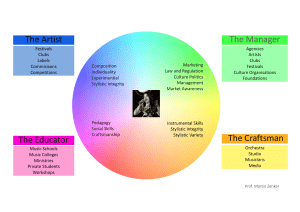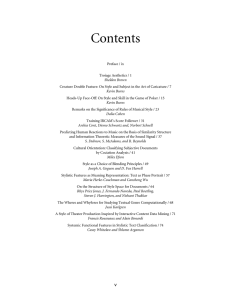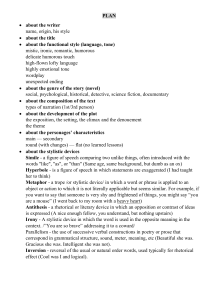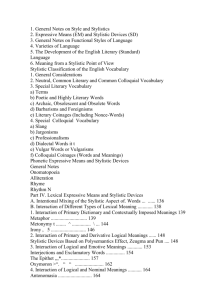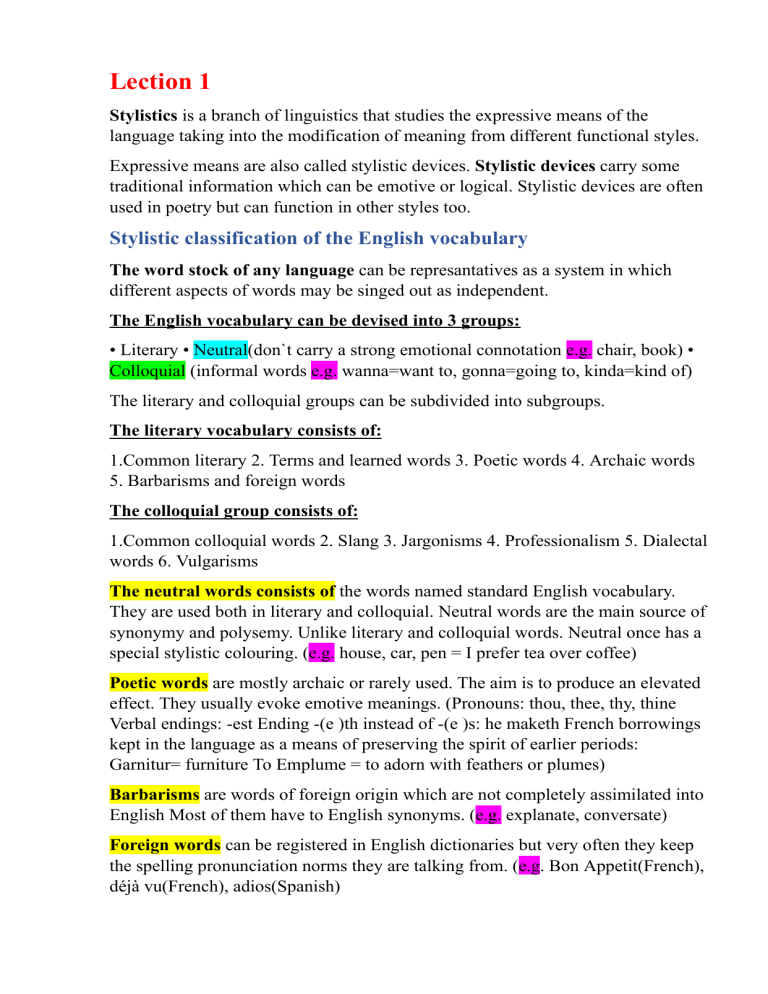
Lection 1 Stylistics is a branch of linguistics that studies the expressive means of the language taking into the modification of meaning from different functional styles. Expressive means are also called stylistic devices. Stylistic devices carry some traditional information which can be emotive or logical. Stylistic devices are often used in poetry but can function in other styles too. Stylistic classification of the English vocabulary The word stock of any language can be represantatives as a system in which different aspects of words may be singed out as independent. The English vocabulary can be devised into 3 groups: • Literary • Neutral(don`t carry a strong emotional connotation e.g. chair, book) • Colloquial (informal words e.g. wanna=want to, gonna=going to, kinda=kind of) The literary and colloquial groups can be subdivided into subgroups. The literary vocabulary consists of: 1.Common literary 2. Terms and learned words 3. Poetic words 4. Archaic words 5. Barbarisms and foreign words The colloquial group consists of: 1.Common colloquial words 2. Slang 3. Jargonisms 4. Professionalism 5. Dialectal words 6. Vulgarisms The neutral words consists of the words named standard English vocabulary. They are used both in literary and colloquial. Neutral words are the main source of synonymy and polysemy. Unlike literary and colloquial words. Neutral once has a special stylistic colouring. (e.g. house, car, pen = I prefer tea over coffee) Poetic words are mostly archaic or rarely used. The aim is to produce an elevated effect. They usually evoke emotive meanings. (Pronouns: thou, thee, thy, thine Verbal endings: -est Ending -(e )th instead of -(e )s: he maketh French borrowings kept in the language as a means of preserving the spirit of earlier periods: Garnitur= furniture To Emplume = to adorn with feathers or plumes) Barbarisms are words of foreign origin which are not completely assimilated into English Most of them have to English synonyms. (e.g. explanate, conversate) Foreign words can be registered in English dictionaries but very often they keep the spelling pronunciation norms they are talking from. (e.g. Bon Appetit(French), déjà vu(French), adios(Spanish) Slang means all the words that are below the standard usage in a modern English. (e.g. lit – smth excellent, chill – relax, squad – group) Cockney is the type of speech used by people from the East End of London. OR Cockney is an accent and dialect of English, mainly spoken in London and its environs, particularly by working-class and lowers middle-class Londoners. (e,g, apples and pears – stairs – Im going up the apples…) Jargon is a group of words that exist in almost every language. Its aim is to preserve secrecy within a certain social group. Jargonisms are usually old words with entirely new meanings which can be understood only by the people inside the social group. (e.g. break a leg, lingo, green room) Professionalisms are used in a definite trade or profession by people connected by common interests. They are correlated to terms. (e.g. anesthesia, diagnose, arbitration) Lection 2 Phonetic Stylistic Devices and Graphical Means The stylistic approach isn’t restricted by the structure and sense. It is also connected with a way a word, a phrase, a sentence sounds. The sound of a word often contributes something to the general effect of the message. Phonetic stylistic devices which are most commonly used are: • Onomatopoeia (ономатопія або звуконаслідування) • Alliteration (алітерація) • Rhyme (Рима) • Rhythm (ритм) Onomatopoeia is a combination of speech sounds which imitate sounds produced in nature by people, by animals or by lifeless objects. (e.g. Splash - сплеск Whistle - свист Giggle- регіт, хихикання Bark - гавкання Meow - мявкання Buzz – дзужчання) There are 2 varieties of onomatopoeia: • Direct • Indirect Direct is a particular imitations of the sound that is easily recognisable (e.g. Ku-ku/ cuckoo Ding-dong Bang Woof-woof) Indirect (sometimes called echo-writing) is combination of sounds that are like the sound imitated but have a strict language form. (e.g. Whistle, giggle, bubble) Alliteration(повторення пригголосних) is a phonetic stylistic device which aims at making melodic effect to the utterance. This effect is produced by the repetition of similar sounds, very often they are consonant. (e.g. Mickey Mouse made magical memories, Tiny Tim tiptoed to the town) Assonance(повторення голосниих) is the repetition of similar stressed vowels within one line. (e.g. the cat ran past the fast black rat, the cool moon) Rhyme is the repetition of identical or similar sounds combination of words. Rhyming words are generally placed at a regular distance from each other. Identify and similarity of sound combination may be relative. (e.g. no pain no gain, easy peasy lemon squeezy) Vowel rhymes and consonant rhymes in vowel rhymes the vowels of the syllables in corresponding words are identical (e.g. flesh-fresh-press, lake-late, meet-fleet). Consonant rhymes, on the contrary, show concordance in consonant and disparity in vowels as worth-forth, tale-tool-treble-trouble, flung-long. Rhythm is an alliteration of stresses and unstressed syllables at regular periods of time. (e.g. I`m going to the store to buy some groceries, Gm howya today?) Graphical stylistic devices are stylistic devices which serve to convey in the written form those emotions which in the oral speech are expressed by intonation and stresses. All types of punctuation can be used to reflect the intonation of the speaker. They can be: hyphens, ellypsis, rhetoric questions and so on. The changed type: italics(курсив), bold type(жирний), spelling multiplication (laaarge). Graphing is a misspelling thet can also be a stylistic device. It is used to show the educational background of the person (especially in literature), the age of the person, psychological or emotional state, physical state. (e.g. “But, soft! What light through younder window breaks? – from Romeo and Juliet) Graphon is also used in advertisements to attract people’s attention. No one will luv you Счастье (e.g. the famous coca-cola) Graphons are often used in a telegraph or message style. H8 - hate, CU(see you), 4U (for u) Lection 3 Lexical stylistic devices There are 3 groups: 1. The interaction of different types of lexical meanings 1 - primary dictionary and contextually imposed (metaphor, irony) 2 - primary and derivative logical meanings (zeugma, pun) 3 - logical and emotive meanings (epithet, oxymoron) 4 logical and nominative meanings (antonomasion) 2. The intensification of the feature (simile, hyperbole, periphrasis) 3. Peculiar use of set expressions (cliches, proverbs, epigraph, quotations) Metaphor is a relation between the dictionary and contextual logical meanings based on the similarity of certain properties or features of the two corresponding concepts. (e.g. time is money, life is a journey) Metaphor realises two syntactical meanings simultaneously. Metaphors can belong to the all parts of speech both meaningful and auxiliary. Metaphor as a stylistic device can be classified according to the degree of unexpectedness. Metaphor can be genuine (absolutely unexpected and quite unpredictable) and trite (банальний) often used and quite expected. Stylistic function of a metaphor is to make a description more vivid and express the individual attitude. Metonymy is a stylistic device based on a different type of relation between the dictionary and contextual meanings based not an similarity but an association connecting the two concepts. Metonymy is a stylistic device based on a different type of relation between the dictionary and contextual meanings based not an similarity but an association connecting the two concepts (e.g. the dish is delicious, I need to hit the books) The association can be: • Between the symbol and the thing it denotes (A big hat enter the ball) • The relation between the instrument and the action performed with this instrument (This pen is rather sharp) • The relation between the container and the thing in contains (I drank one more cup) • The concrete is put for the abstract (It was a representative meeting) • A part is put for the whole (the crown is very important in Great Britain) Irony is a stylistic device based on two logical meanings: dictionary and contextual but this two are usually in opposition to each other one thing is said and the other (opposite) is implied. (e.g. “What a beautiful day!” – when it`s raining) Zeugma is the use of the word in the same grammatical but difference semantic relation (on the one hand literal but the other transferred) The same in the privileged position and in the middle of the room Zeugma is used to attract attention to what is said and often to create a humorous meaning to what is said. (e.g. she broke his heart and his favorite record, he lost his keys and his temper) Pun is another stylisuc device also based on the interacuon of two well known meanings or a word or a phrase. ⬅ каламбур (e.g. I`m glad I know sign language it`s pretty handy) Epithet is based on the interplay of emotive and logical meaning in an attractive word, phrase or even sentence, used to characterise an object and painting out to the reader some of the properties or features of the object with the aim of giving an individual perceptions and evaluation of these features or properties. (e.g. the sweet melody, the beautiful sunset, the Great Bard, the Man of Steel) Classification of epithets From the point of view of their compositional structure epithets may be divided into: 1) Simple (adjectives, nouns, participles ) (e.g. he looked of them in animal panic) 2) Compound (e.g. Apple-faced man) 3) Sentence and phrase epithets (e.g. It is his do (it yourself attitude)) 4) Reversed epithets - composed of 2 nouns linked by on of phrase (e.g. A shadow of a slime) Semantically according to I.Garpelin: 1.Associated with the noun following it, painting to a feature which is essential to the objects they describe (e.g. dark forest, careful attention) 2.Unassociated with the noun, epithets that add a feature which is unexpected and which strikes the reader (e.g. smiling Sun, voiceless sound) Oxymoron is a combination of two words in which the meaning is opposite in sense (e.g. Speaking silence, cold fire, living death) Close to oxymoron is paradox - a statement that is a absurd on the surface. (e.g. War is peace. The worse - the better.) Trite oxymoron (e.g. Awfully beautiful) If the primary meaning of qualifying word changes the stylistic effect of oxymoron is lost. In oxymoron the logical meaning holds fast because there is no true word combination. Lection 4 Antonomasia (переносне значення) is the result of interaction between logical and nominal meaning of the word when: The proper name of a person who is famous for some reason is used for another person having the some features. (e.g. He is a Sherlock Holmes) • A common noun is used instead of a proper name. (e.g. I agreed with you Ms.Logic; My dear forgetfulness what can we do?) Simile (порівняння) is a stylistic device which is used to intensify some feature of the concept. The properties of an object may be viewed from different size, e.g.: action, manner, stage So similes may be based on adjective, adverb(modifiers) or verb (syntactic function). Similes have connected words: like, as, such as, as of. (e.g. He is an elephant (metaphor) He is like an elephant (simile)) Periphrasis (перефраз) is used to name some object or phenomenon in an indirect way / in a roundabout way. Usually a longer phrase is used instead of a short one. Some periphrasis are traditional (traite) (e.g. the city of lights – refer to Paris, the kind of pop – Michael Jackson) Can be divided into: • Logical - which is based on a real properties of an object • Figurative (she is going to tie a knot (вона збирається одружитись)) The variety of periphrasis is euphemism Euphemism (ефимізм) is a stylistic device used to avoid some unpleasant or tabu. (e.g. passed away=died, let go=fired, comfort room=bathroom) Hyperbole (гіпербола) is a stylistic device of deliberate overstatement overestimation or exaggeration. The aim of hyperbole is to intensity one of the features to such a degree which is absurd. (e.g. I haven’t seen you for ages, I`m so hungry I could eat a horse) Lection 5 A cliché is generally defined as an expression that has become trite (банальний, затасканий) in other words it has become stereotyped. Cliché is a kind of stable word combination which has become familiar and has been accepted as a unit of the language. (e.g. It`s a piece of cake, better late than never) Proverbs are short, well known, supposedly wise things, usually in a simple language. (e.g. Never say never When pigs flying) Proverbs are a part of a culture. They usually passed from generation to generation. Epigram is a short, clever, amusing, saying or even a poem. (e.g. A thing of beauty is a joy forever (Краса -це вічна радість). Quatation is a phrase or sentence taken from a work of literature or other piece of writing which is repeated in order to prove a point or support an idea. They are marked graphically by quotation marks, by italics, by dashes. (e.g. “The only way to do great work is to love what you do – Steve Jobs) Allusion is an indirect reference by word or phrase to a historical, literary, mythological fact made in the course of speaking or writing. The use of allusion presupposed knowledge of the fact or thing which is alluded. (e.g. She had a Mona Lisa smile, he was a real Romeo with the ladies) Lection 6 Stylistic devices based on various types of conjunctions. Asyndeton(відсутність) – безсполучниковий зв’язок — is a syntactic stylistic device consisting in the deliberate avoidance of conjunction. Differently, from the connection of separate clauses by means of conjunction asyndeton is based on implied relations between them. The aim of asyndeton is to make part of a sentence more emphatic due to their syntactical independence. Asyndeton occurs most frequently within the range of compound sentences when the conjunction between them are omitted (e.g. He was gone, he couldn`t stay, she laughed she cried she danced) Poly(many)syndeton – is a syntactic-stylistic device opposite to asyndeton. It is an abundance of conjunctions in a sentence which are repeated in close succession. May serve to stress the similar nature or close connection between parts of the utterance (висловлення). It may also express event following one another in close succession to intensify the narration (e.g.I want pizza and fries and soda and ice cream) It is often used to express various emotions such as disgust, fear, exhaustion (negative emotions). Repetition devices is a syntactical stylistic device consisting in repeating the same word or word combination to make the utterance more expressive. Can be divided into: • lexical repetition – it may be simple (is using one and the same member of a sentence in succession: subjects, predicates, objects. May be repeated and emphasis. May express various emotions and frequently occurs together with polysyndeton (e.g. He talk and talked and talked) and synonymical consists in using close synonyms in succession (e.g. He liked\adored/loved/fancied her.) It includes anaphores, epiphores, anadyplosis, framing and syntactic tautology. Anaphor – carry back – is a repetition device where the same words or word are repeated at the beginning. It is used to lay emotional stress on a part of the utterance (e.g. Perhaps, he is suffering, perhaps, he was alone.) Epiphor - is the repetition of words or word at the end of the clause (e.g. She lived there for years, She walked there for years, She shopped there for years.) It is used sometimes to create a humorous effect. Anadiplosis – is the repetition of the words or word used in the previous clause – підхват. It is used to stress the most important parts of the utterance (e.g. It was not easy to realize his sorrow at that time, the sorrow he trued to hide.) Framing – is a repetition of the opening of the words at the end of a clause or a sentence (e.g. Everyone`s hand was against him, it`s not a diet it`s a lifestyle change) Syntactic tautology is the repetition of the sentence member usually the subject expressed by a noun by means of a corresponding pronoun. It is used to emphasize the object spoken about (e.g. And the books, they(the books) stood on the shelf/My friend, he said nothing, he was just standin and watching) Functional Style A functional style is a socially accepted stereotips behaviour closely connected with a human social activity. It is a system of expressive means and vocabulary answering the need of the sphere of human activity. Each style can be recognized by one or more leading features which are especially particular. The English language has a number of functional styles which distinctionally one from another. They fold into several variants and are commonly divided into 5 classes: 1. The Belles-lettres style 2. Publicistic style 3. Newspapers style 4. Scientific style 5. Official documents Some of these classes are subdivided into smaller groups: The Belles-lettres style fold into poetry, emotive prose and drama Publicistic style is subdivided into oratory, speeches, essays and articles Newspapers style has – brief new items, headlines, advertisement and announcement, the editorial The other 2 groups are usually not subdivided. Among functional style, there is so-called neutral style, that is stylistically non-markt and reflects the norms of the language. It`s serves as the kind of universal background in the texts of any functional type. The Belles-lettres style Poetry The first characteristic of poetry is its forms which is based mainly on the rhythmic and phonetic arrangement of the utterance. Syntactically poetry is shown in a liptical and fragmental sentences in inversion, asyndeton and others. Grammar is not so strict and important for poetry. Rhythm and rhyme are distinguished properties of the poetic substile. Emotive prose Emotive prose is characterized by literal vocabulary, contextual meaning of the words and the authors personal evaluation of things phenomena. Drama The drama is the language of plays. It`s entirely dialog. The authors speech is almost included, except for some remarks and directions, which may be significant sometimes. Publicistic style The publicistic style has spoken varieties in particular the oratorical substyle. Oratorical substyle means direct contact with the listeners and combines syntactical, lexical and phonetic peculiarities of both written and spoken varieties of the language. Typical features of the spoken variety are: 1) direct address to the audience, like ladies and gentlemen; boys and girls… 2) the use of the second person pronoun “you” (Do you understand me? You know about that) 3) sometimes contractions I`ll, we won`t, they haven`t 4) the use of colloquial words This style is abandoned in speeches on political and social problems, orations and addresses on different solum, occasions in ceremonies and debates, judies and laws Essay The essay is a literally composition of moderate length on philosophical, social, aesthetic or literary subjects. The most characteristic language features of the essay are: 1) brevity of expression 2) the use of the first person singular 3) a rather expanded of connectives 4) a wide use of emotive words 5) the use of similies and metaphors Article The articles are characterized by brevity of expression, using abstract words, not frequent emotional language and concentration on a particular topic. Newspaper style English newspaper style may be defined as a system of interrelated lexical, phraseological and grammatical means, which is perceived by the community of native speakers as a separate unity that basically the purpose of informing and instructing the reader. The primary function of the newspaper style is to impact information according to 4 basic newspaper features: 1) brief news items 2) advertisements and announcements 3) the headline 4) the editorial Brief news items The function of the brief news items is to inform the reader. BNI state only facts without giving comments. They lack any individuality or emotional coloring. Stereotyped forms of language expression prevail. The style is characterized by: 1) special political and economic terms 2) extended political vocabulary (non-terms) 3) newspapers cliches or set-phrases 4) abbreviations 5) neologisms Besides there are some grammar peculiarities that characterize the style: 1) complex sentences with a developed system of clauses 2) verbal constructions (complex object, subject, passive constructions) 3) syntactical complexes 4) attributive noun groups 5) specific word odor Advertisements and announcements The function is to inform the reader. There are 2 basic types of adv. and ann. in the modern English newspaper: classified (various kinds of information are arranged according to subject method into section, each section barring an appropriate name) and non-classified (the variety of language forms and subject matters are used all together – typographical, graphical stylistic). The headline The headline is the title given to the news item or a newspaper article. The main function of headline is to inform the reader briefly what the news that follows is about. Syntactically headlines are very short sentences of phrases, variety of pattern, such as: 1) full declarative sentence (full statements) 2) interrogative sentences 3) nominative sentence (usually based on the noun) 4) elliptical sentence (short sentence where all parts exist) 5) sentences with articles omitted 6) phrases with verbal 7) questions in the form of statements 8) complex sentences 9) direct speech The editorial Editorials are intermediate phenomena, bearing the characteristics of both the newspaper style and publicistics. The function of the editorial is to influence the reader by giving an interpretation of certain facts. Like any publictics writing, editorials appeal not only to reader is mind but to their feeling as well. The editorial is the most emotional style compared to other styles. Scientific prose The aim of this functional style is to prove a hypothesis, to create new concepts, to dwell on the internal laws of existence relation between phenomena. The language means which are used in this style tend to be objective, precise, unemotional. There is the most generalized form of expression. There are some typical linguistic features in scientific prose: 1) logical sentence of utterances 2) the use of terms 3) prevailing the sentence patterns of 3 types – postulatory, argumentative and formulative 4) the frequent use of foot notes Official documents style The style is not connatural and represented by the following variants: 1) the language of business documents 2) the language of legal documents 3) the language of diplomacy 4) the language of military documents The style has a definite communicative aim and accordingly has its own system of interrelated language and stylistic means. The aim of communication in this style is to reach agreement between 2 contradicting parties. The functional style of official documents also has some peculiarities: 1) the use of abbreviations, symbols and contractions 2) the use of words in their logical dictionary meaning 3) various sentence patterns 4) absence of any emotions Ellipsis – is a syntactic stylistic device based on reduction of the initial sentence model. Elliptical sentence usually has no subject or predicate or both. The main parts of elliptical sentences are omitted by the speaker intentionally to spare his time to save him from needless efforts. Elliptical structures may reveal such emotions as excitements, impatience, delight and so on. As a stylistic device ellipsis is often an effective means of the characters portrait. Omitted parts should be obvious. Aposiopesis (break in the narrative) – is a syntactic stylistic device based on reduction of the sentence. It is realized through incompleteness of sentence structure, but unlike ellipsis, aposiopesis appears when the speaker is unavailing to proceed and breaks off his narrative. This abruption is usually marked with 3 dots … Nominative sentences - belong to the syntactic stylistic devices based on reduction of the sentence structure. A nominative sentence is a variant of the one member structures. It has neither subject nor predicate. It is called nominative because its basic component is a noun or a noun like element (gerund or numeral). A sequence of nominative sentences makes description of events more dynamic. They usually depicted the time of the action, the place of the action, the participants of the action and so on. Inversion – is a syntactic stylistic device based on change of word order. Inversion can be grammatical and stylistic. Inversion as the stylistic phenomenon is intentional charging word order to emphasize the part of sentence. Detachment – is a syntactic stylistic device based on change of word order. Detached construction is a secondary part of a sentence placed, so that it seems formally independent of the word. It logically refers to. The detached part being torn away from its referent as use of greater degree of significance. Parallel construction - belong to the syntactic stylistic devices based on interaction of syntactic structures in context. A parallel construction or parallelism produces two or more syntactic structure according to the same syntactic pattern. Stylistic parallelism is polyfunctional. It creates rhythm in poetry, makes speech (especially in publicistic style) Rhetorical questions - belong to the syntactic stylistic devices based on transposition of meaning and connection of the parts. Rhetorical question are not grammatical question and often affirmative or negative shape. A rhetoric question needs no answer because the answer is usually quite obvious.
